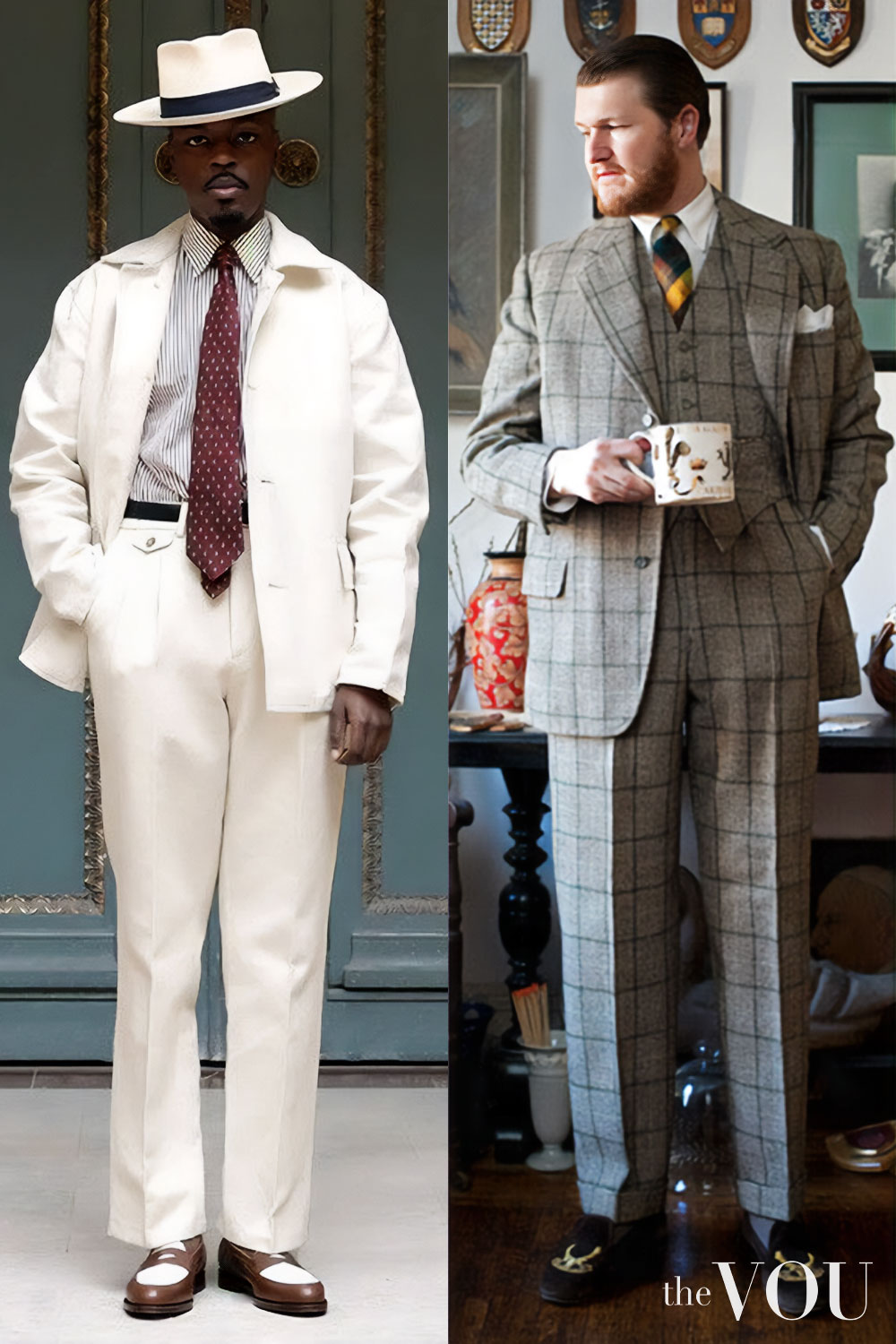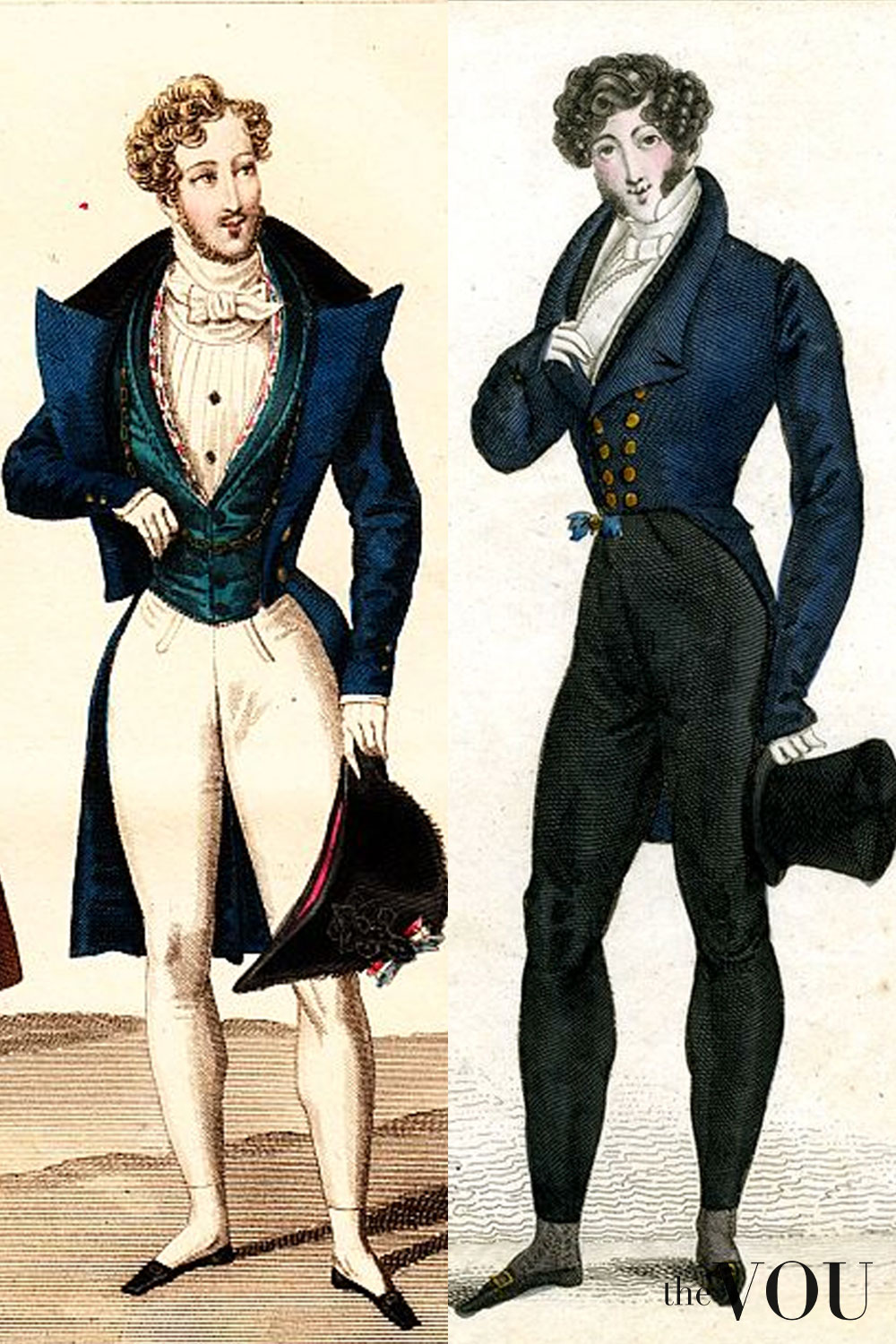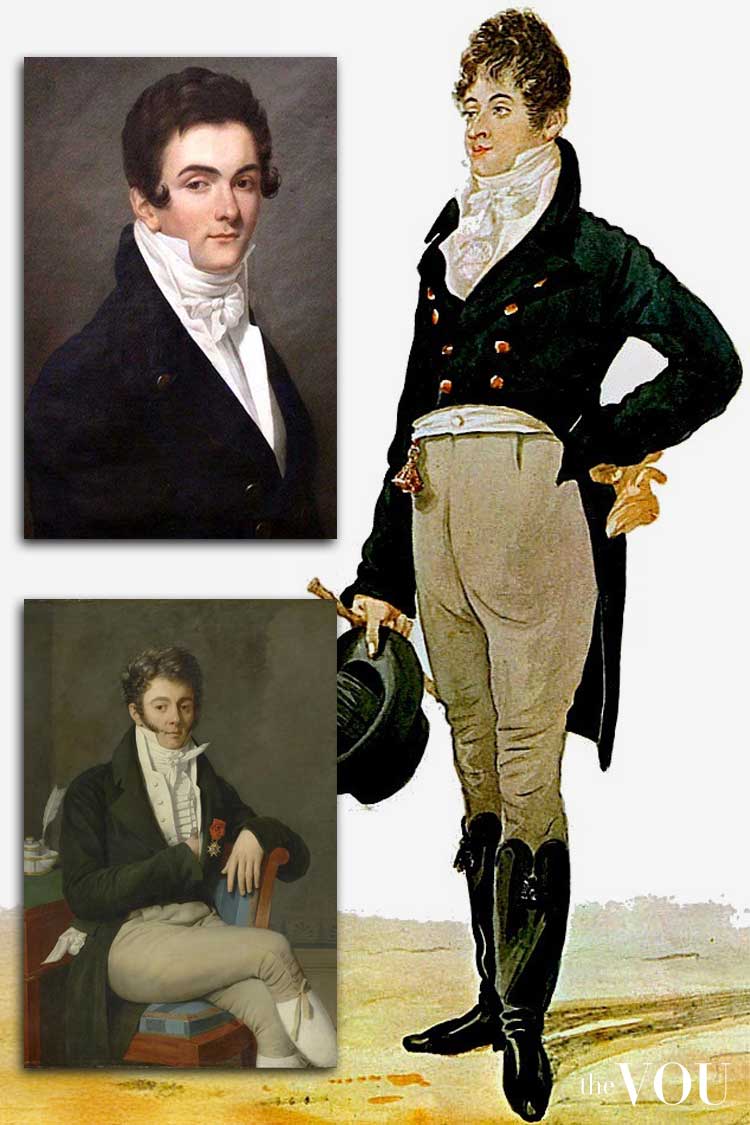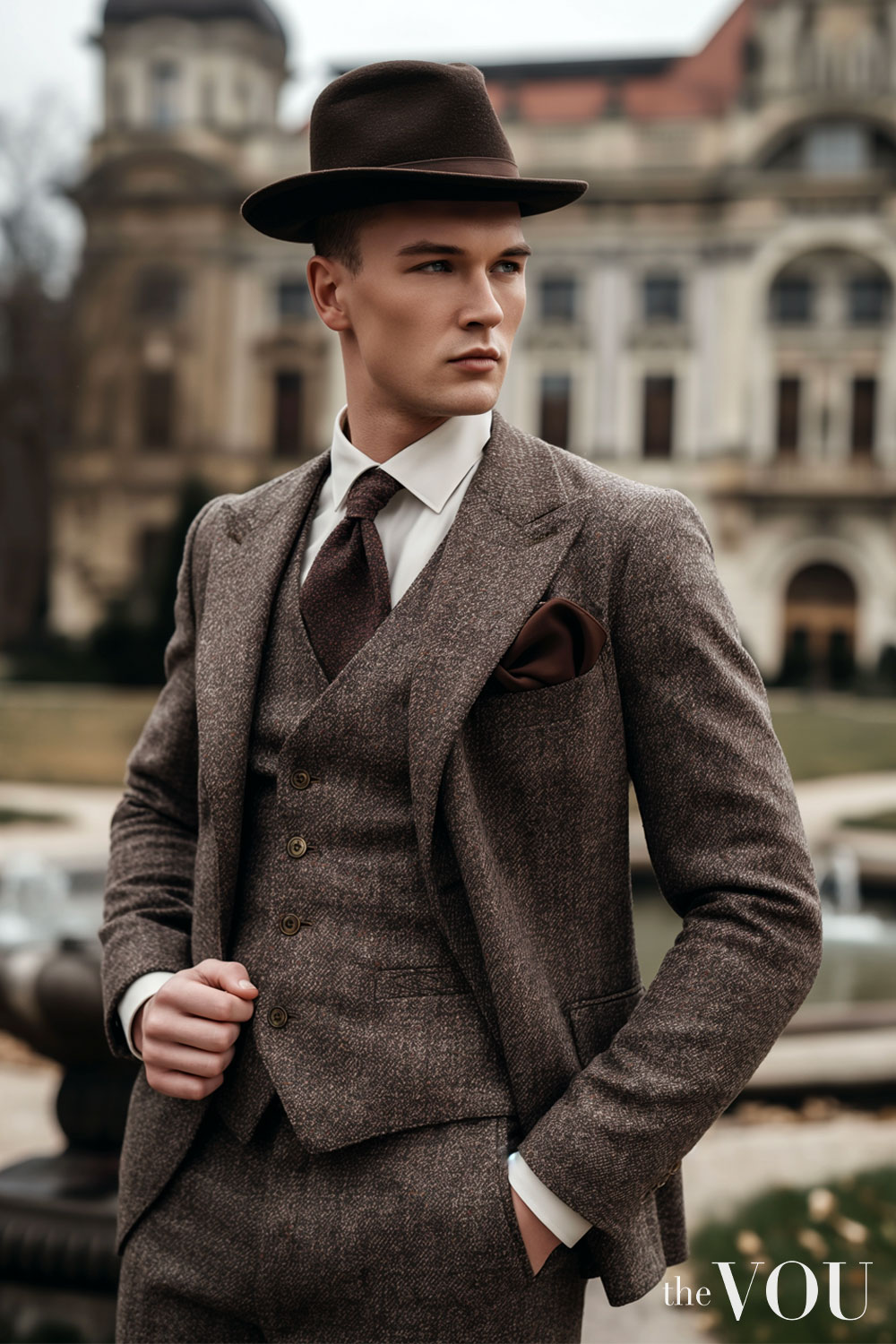The dandy look for men is an iconic expression of elegance, tradition, heritage, and stylistic sophistication.
Characterised by high-quality garments, a touch of eccentricity, and an obsession with details, the dandy way of dressing showcases a sophisticated man of classic aesthetic.
During Britain’s late 18th and early 19th centuries, men who stood out for their impeccable elegance and refined taste were called ‘dandies.’
What is Dandy?
A dandy is a man who values physical appearance, personal grooming, refined language, and leisurely hobbies.
A dandy can be a self-made man who emulates the aristocratic style of life – regardless of his origins, class status, or background.

The Victorian novelist George Meredith defined the dandy as a person who cultivated a persona characterised by extremely posed cynicism, also known as “intellectual dandyism,” in social settings.
The poet Charles Baudelaire portrayed the dandy as an existential reproach to the conformity of contemporary middle-class men, cultivating the idea of beauty and aesthetics akin to a living religion.

The dandy lifestyle, in certain respects, resembles spirituality and stoicism as an approach to daily life.
Contrary to what many believe, dandyism is not an excessive delight in clothes and material elegance.
For the perfect dandy, these material things are no more than the symbol of the aristocratic superiority of mind.
Modern Dandyism – The Origin
Early manifestations of dandyism were Le petit-maître (the Little Master) and the musk-wearing Muscadin ruffians of the middle-class Thermidorean reaction (1794–1795).
Modern dandyism, however, emerged in stratified societies of Europe during the 1790s revolution periods, especially in London and Paris, as a form of Romanticism.
The linkage of clothing and political protest was a particularly English characteristic in 18th-century Britain; the sociologic connotation was that dandyism embodied a reactionary form of protest against social equality and the levelling effects of egalitarian principles.

Thus, the dandy represented a nostalgic yearning for feudal values and the ideals of the perfect gentleman and the autonomous aristocrat—referring to men with self-made personas.
Paradoxically, the dandy’s social existence required the gaze of spectators, an audience, and readers who consumed their “successfully marketed lives” in the public sphere.
Figures such as playwright Oscar Wilde and poet Lord Byron personified the dual social roles of the dandy: the dandy-as-writer and the dandy-as-persona.
Each role was a source of gossip and scandal, confining each man to the realm of entertaining high society.
British Dandyism
Beau Brummell (George Bryan Brummell, 1778–1840) was the model British dandy from his days as an undergraduate at Oriel College, Oxford, and later as an associate of the Prince Regent (George IV)—all despite not being an aristocrat.
Always bathed and shaved, always powdered and perfumed, always groomed and immaculately dressed in a dark blue coat of plain style.
Sartorially, the look of Brummell’s tailoring was perfectly fitted, clean, and displayed much linen; an elaborately knotted cravat completed the aesthetics of Brummell’s suite of clothes.
During the mid–1790s, the handsome Beau Brummell became a personable man-about-town in Regency London’s high society, who was famous for being famous and celebrated “based on nothing at all” but personal charm and social connections.

During the national politics of the Regency era (1795–1837), those days Prime Minister William Pitt the Younger introduced the Duty on Hair Powder Act (1795) to fund Britain’s war efforts against France.
Pitt discouraged using foodstuffs as hair powder, the dandy Brummell already had abandoned wearing a powdered wig and wore his hair cut a la Brutus, in Roman fashion.
Moreover, Brummell also led the sartorial transition from breeches to tailored pantaloons, which eventually evolved into modern trousers.
Upon coming of age in 1799, Brummell received a paternal inheritance of thirty thousand pounds sterling, which he squandered on a high life of gambling, lavish tailors, and brothel visits.
Eventually declaring bankruptcy in 1816, Brummell fled England to France, where he lived in poverty and was pursued by creditors; in 1840, at the age of sixty-one years, Beau Brummell passed away in a lunatic asylum in Caen, marking the tragic end to his once-glamorous legacy.
Despite his ignominious end, Brummell’s influence on European fashion endured, with men across the continent seeking to emulate his dandyism.
Among these was the poetic persona of Lord Byron (George Gordon Byron, 1788–1824) wore a poet’s shirt featuring a lace collar, a lace placket, and lace cuffs in a portrait of himself in Albanian national costume in 1813.
Count d’Orsay (Alfred Guillaume Gabriel Grimod d’Orsay, 1801–1852), a prominent figure in upper-class social circles and an acquaintance of Lord Bryon, likewise embodied the spirit of dandy within elite British society.
In the chapter “The Dandiacal Body” of the novel Sartor Resartus (Carlyle, 1831), Thomas Carlyle described the dandy’s symbolic social function as a man and a persona of refined masculinity:
“A Dandy is a Clothes-wearing Man, a Man whose trade, office, and existence consists in the wearing of Clothes. Every faculty of his soul, spirit, purse, and person is heroically consecrated to this one object, the wearing of Clothes wisely and well: so that as others dress to live, he lives to dress.”
And now, for all this perennial Martyrdom, Poesy, and even Prophecy, what is it that the Dandy asks in return?
Solely, we may say, that you would recognise his existence; would admit him to be a living object, or even, failing this, a visual object or thing that will reflect light rays.
In the mid-19th century, amidst the restricted palette of muted colours for men’s clothing, the English dandy dedicated, meticulous attention to the finer details of sartorial refinement (design, cut, and style), including:
“The quality of the fine woolen cloth, the slope of a pocket flap or coat revers, exactly the right colour for the gloves, the correct amount of shine on boots and shoes, and so on. It was an image of a well-dressed man who, while taking infinite pains about his appearance, affected indifference to it. This refined dandyism continued to be regarded as an essential strand of male Englishness.”
French Dandyism
In monarchic France, dandyism was ideologically bound to the egalitarian politics of the French Revolution (1789–1799).
Thus, the dandyism of the jeunesse dorée (the Gilded Youth) was their political statement of aristocratic style to differentiate themselves from the working-class sans-culottes, from the poor men who owned no stylish silk knee-breeches.

In the late 18th century, British and French men abided by Beau Brummell’s dictates about fashion and etiquette, especially the French bohemians who closely imitated Brummell’s dress, manner, and style habits.
At a time of political progress, French dandies were celebrated as social revolutionaries.
They were self-created men with consciously designed personalities, men whose way of being broke with inflexible traditions that limited the social progress of greater French society.
Thus, with their elaborate dresses and decadent lifestyles, the French dandies conveyed their moral superiority and political contempt for the conformist bourgeoisie.
Regarding the social function of the dandy in a stratified society, like the British writer Carlyle, in Sartor Resartus, the French poet Baudelaire said that dandies have:
“…no profession other than elegance . . . no other [social] status, but that of cultivating the idea of beauty in their persons. . . . The dandy must aspire to be sublime without interruption; he must live and sleep before a mirror.”
Likewise, French intellectuals investigated the sociology of the dandies (flâneurs) who strolled Parisian boulevards.
In the essay “On Dandyism and George Brummell” (1845), Jules Amédée Barbey d’Aurevilly analysed Beau Brummell’s personal and social career as a man-about-town who arbitrated what was fashionable and what was unfashionable in polite society.
In the late 19th century, dandified bohemianism was characteristic of the artists who were the Symbolist movement in French poetry and literature, wherein the “Truth of Art” included the artist in the work of art.
Black Dandyism
Black dandies have existed since the beginnings of dandyism and have been formative for their aesthetics in many ways.
Maria Weilandt in “The Black Dandy and Neo-Victorianism: Re-fashioning a Stereotype” (2021) critiques the history of Western European dandyism as primarily centred around white individuals and the homogenisation whiteness as the figurehead of the movement.
It is important to acknowledge Black dandyism as a distinct and highly political effort at challenging stereotypes of race, class, gender, and nationality.
British-Nigerian artist Yinka Shonibare (b. 1962) employs neo-Victorian dandy stereotypes to illustrate Black men’s experiences in Western European societies.

Shonibare’s photographic suite Dorian Gray (2001) refers to Oscar Wilde’s literary creation of the same name, The Picture Of Dorian Gray (1890), but with the substitution of a disfigured Black protagonist.
As the series progresses, readers soon notice that no real picture of “Dorian Gray” exists but only illustrations of other white protagonists.
Through this theme of isolation and Otherness, the Black Dorian Gray becomes Shonibare’s comment on the absence of Black representation in Victorian Britain.
Shonibare’s artwork Diary of a Victorian Dandy (1998) reimagines one day in the life of a dandy in Victorian England, through which the author challenges conventional Victorian depictions of race, class, and British identity by depicting the Victorian dandy as Black, surrounded by white servants.
Black dandyism catalyses contemporary identities to explore self-fashioning and expressions of neo-Victorian Blacks:
- The Black dandy’s look is highly tailored – the antithesis of baggy wear as lack dandyism rejects this look.
- The Black dandy is often making a concerted effort to juxtapose himself against racist stereotyping seen in mass media and popular culture.
- For dandies, dress becomes a strategy for negotiating the complexities of Black male identity.
“Dandy Jim of Carolina” is a minstrel song that originated in the United States during the 19th century.

It tells the story of a character named Dandy Jim, who is depicted as a stylish and flamboyant individual from the state of Carolina.
The song often highlights Dandy Jim’s extravagant clothing, charm, and prowess with the ladies.
While the song does not explicitly address race, Dandy Jim’s stylish and flamboyant persona aligns with aspects of Black dandyism, a cultural phenomenon characterised by sharp dressing, self-assurance, and individuality within Black communities.
According to the day’s standards, it was ludicrous and hilarious to see a person of perceived lower social standing donning fashionable attire and “putting on airs.”
For most of racist 19th-century America, a well-dressed African American was an odd thing, and naturally, someone of that ilk would be seen as acting out of place.
While potentially rooted in caricature or exaggeration, the representation of Dandy Jim nonetheless contributes to the broader cultural landscape surrounding Black dandyism and its portrayal in American folk music.
Modern Dandy – How to Dress Like One
 |
 |
 |
 |
 |
 |
 |
 |
 |
 |
 |
 |
 |
 |
 |
 |
The dandy style is not for everyone, perhaps because it is “the style” par excellence, something you can’t easily build.
Therefore, it is not a good idea to impose an outfit that does not reflect one’s personality; as Baudelaire said: “Dandy you born.”
Dandyism is not an unbridled taste in clothing and material elegance, as many people seem to believe.
For the perfect dandy, these things are only a symbol of the aristocratic superiority of his mind.
Dandyism is a way of life and has to be found in every detail.
Dandy style is for those who love to express their personality through clothes, attitudes, and ways of doing things.
And for those of you, dandy inside, here is a little help to become dandy even outside.
Modern Dandy Style Wardrobe Essentials
Nowadays, the dandy look for fashion men is still present even if the style has changed slightly.
Instead of velvet breeches and sunflowers, they wear tight-fitting or chick suits. They also wear matching shirts with silk scarves, ties, or bow ties.

Therefore, they must shine for a certain touch. Generally, the outfit has to look clean and well-groomed; a hat is also appropriate.
The fabrics are noble, such as cashmere and silk, mixed with wool and cotton sateen.
The accessories should be kept simple but still high-quality—the best choices are cufflinks, watches, belts, and bow ties, which are perfect for completing any outfit.
Tailored Suits
Tailored suits are the cornerstone of dandy style. Opt for clothes with impeccable cuts, clean lines, and high-quality fabrics.
Choose classic colours like grey, blue, or black, but don’t hesitate to experiment with unusual details or refined patterns.
The best tailored suit is a two-button jacket and a slim trouser with clean, elegant, sober lines. Focus your attention on fabrics.
Wearing checked patterns, stripes, Prince of Wales, and Tartan can obtain a wow effect. If you want to dare, you can try the suit with Gilet, the direct heir of Lord Brummel’s waistcoat.
But keep in mind: less is more, even in sartorial style for the new dandy. Before opting for the most eccentric outfit in your wardrobe, always value the situation!
Dress Shirts
Shirts are a key element of the dandy look – shirts with high collars, elegant cuffs, and fine details like mother-of-pearl buttons or understated embroidery.
Choose neutral colours or subtle prints to balance sobriety and elegance.
Dress Shoes
Dress shoes are essential for a complete dandy look. Opt for loafers, brogues, Oxfords, or leather dress boots.
Ties and Pocket Squares
Ties are a way to express your personality in a dandy look. Opt for silk neckties, bow ties, ascots, or cravats with subtle prints or signature details like pins or brooches.
Top them off with a matching pocket square for a touch of class.
Hats and Caps
Hats are an iconic element of the dandy style. To complete your look, choose a quality hat like a fedora, trilby, or felt hat.
Cufflinks
A true gentleman needs cufflinks for his look. They are small but perfect for any event, such as a business lunch or a party.
What appears more high-quality than fine silver with precious wood?
Take the First Step With The VOU’s Styling Quizzes
Start your style journey with our free resources. First, take our Face Shape Quiz to confirm your face shape and receive initial styling guidance.
Then, discover your most flattering colours with our Seasonal Colour Analysis Quiz.
Learn which garment styles suit you best through our Body Shape Quiz, and find your ideal personal style with our Fashion Style Quiz.
Transform Your Image with The VOU’s Professional Guidance
For comprehensive image development that goes beyond hat selection, The VOU offers expert styling services to ensure your complete look projects success and sophistication.
Our Professional Face Shape Analysis package provides you with a scientific analysis of your exact face shape, personalised hairstyle recommendations, customised facial hair styling guide, expert eyewear selection guidance, and detailed grooming recommendations tailored to your unique features.
For the most comprehensive transformation, consider our Complete Image Transformation Package.
This premium service includes our Professional Face Shape Analysis, Seasonal Colour Analysis, Body Shape Analysis, Fashion Style Analysis, Wardrobe Curation Guide, and Personal Brand Development.
Through this complete package, you’ll develop a cohesive style that communicates success and sophistication across all aspects of your appearance.
With years of expertise in high-end fashion collabs and a PhD in Sustainable Fashion, Ru specialises in eco-luxe wardrobes for the modern gentleman seeking understated refinement.
With over twenty years of front-row fashion and styling events, collabs with haute-couture houses, and a PhD in Luxury Fashion, Laurenti is an expert in crafting personalised looks that depict old-money sophistication.
After years of managing hundreds of fashion brands from London's office of a global retailer, Mandy has ventured into freelancing. Connected with several fashion retailers and media platforms in the US, Australia, and the UK, Mandy uses her expertise to consult for emerging fashion brands create top-notch content as an editorial strategist for several online publications.
A passionate advocate for inclusivity and diversity, Aidan is the driving force behind The VOU as its Editorial Manager. With a unique blend of editorial acumen and project management prowess, Aidan's insightful articles have graced the pages of The Verge, WWD, Forbes, and WTVOX, reflecting his deep interest in the dynamic intersection of styling with grooming for men and beyond.



Came here searching for dandy style but in a completely different context and found this such a beautiful article, thank you for the style information, I just subscribed with my email.